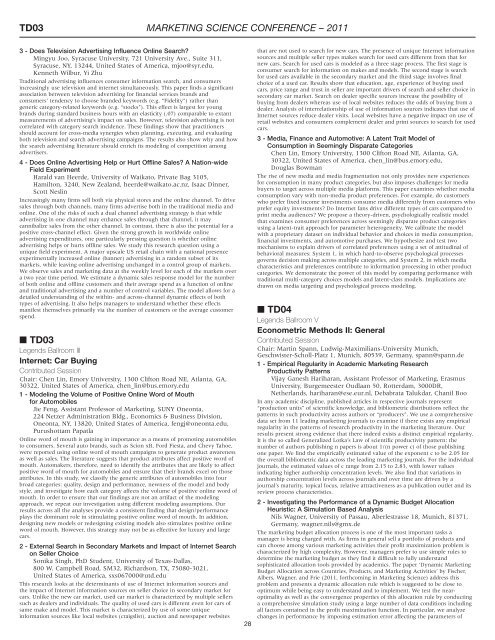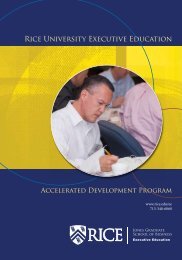Conference Sessions - Jesse H. Jones Graduate School of ...
Conference Sessions - Jesse H. Jones Graduate School of ...
Conference Sessions - Jesse H. Jones Graduate School of ...
Create successful ePaper yourself
Turn your PDF publications into a flip-book with our unique Google optimized e-Paper software.
TD03 MARKETING SCIENCE CONFERENCE – 2011<br />
3 - Does Television Advertising Influence Online Search?<br />
Mingyu Joo, Syracuse University, 721 University Ave., Suite 311,<br />
Syracuse, NY, 13244, United States <strong>of</strong> America, mjoo@syr.edu,<br />
Kenneth Wilbur, Yi Zhu<br />
Traditional advertising influences consumer information search, and consumers<br />
increasingly use television and internet simultaneously. This paper finds a significant<br />
association between television advertising for financial services brands and<br />
consumers’ tendency to choose branded keywords (e.g. “Fidelity”) rather than<br />
generic category-related keywords (e.g. “stocks”). This effect is largest for young<br />
brands during standard business hours with an elasticity (.07) comparable to extant<br />
measurements <strong>of</strong> advertising’s impact on sales. However, television advertising is not<br />
correlated with category search incidence. These findings show that practitioners<br />
should account for cross-media synergies when planning, executing, and evaluating<br />
both television and search advertising campaigns. The results also show why and how<br />
the search advertising literature should enrich its modeling <strong>of</strong> competition among<br />
advertisers.<br />
4 - Does Online Advertising Help or Hurt Offline Sales? A Nation-wide<br />
Field Experiment<br />
Harald van Heerde, University <strong>of</strong> Waikato, Private Bag 3105,<br />
Hamilton, 3240, New Zealand, heerde@waikato.ac.nz, Isaac Dinner,<br />
Scott Neslin<br />
Increasingly many firms sell both via physical stores and the online channel. To drive<br />
sales through both channels, many firms advertise both in the traditional media and<br />
online. One <strong>of</strong> the risks <strong>of</strong> such a dual channel advertising strategy is that while<br />
advertising in one channel may enhance sales through that channel, it may<br />
cannibalize sales from the other channel. In contrast, there is also the potential for a<br />
positive cross-channel effect. Given the strong growth in worldwide online<br />
advertising expenditures, one particularly pressing question is whether online<br />
advertising helps or hurts <strong>of</strong>fline sales. We study this research question using a<br />
unique field experiment. A major upscale US retail chain with a national presence<br />
experimentally increased online (banner) advertising in a random subset <strong>of</strong> its<br />
markets, while leaving online advertising unchanged in a control group <strong>of</strong> markets.<br />
We observe sales and marketing data at the weekly level for each <strong>of</strong> the markets over<br />
a two year time period. We estimate a dynamic sales response model for the number<br />
<strong>of</strong> both online and <strong>of</strong>fline customers and their average spend as a function <strong>of</strong> online<br />
and traditional advertising and a number <strong>of</strong> control variables. The model allows for a<br />
detailed understanding <strong>of</strong> the within- and across-channel dynamic effects <strong>of</strong> both<br />
types <strong>of</strong> advertising. It also helps managers to understand whether these effects<br />
manifest themselves primarily via the number <strong>of</strong> customers or the average customer<br />
spend.<br />
■ TD03<br />
Legends Ballroom III<br />
Internet: Car Buying<br />
Contributed Session<br />
Chair: Chen Lin, Emory University, 1300 Clifton Road NE, Atlanta, GA,<br />
30322, United States <strong>of</strong> America, chen_lin@bus.emory.edu<br />
1 - Modeling the Volume <strong>of</strong> Positive Online Word <strong>of</strong> Mouth<br />
for Automobiles<br />
Jie Feng, Assistant Pr<strong>of</strong>essor <strong>of</strong> Marketing, SUNY Oneonta,<br />
224 Netzer Administration Bldg., Economics & Business Division,<br />
Oneonta, NY, 13820, United States <strong>of</strong> America, fengj@oneonta.edu,<br />
Purushottam Papatla<br />
Online word <strong>of</strong> mouth is gaining in importance as a means <strong>of</strong> promoting automobiles<br />
to consumers. Several auto brands, such as Scion xB, Ford Fiesta, and Chevy Tahoe,<br />
were reported using online word <strong>of</strong> mouth campaigns to generate product awareness<br />
as well as sales. The literature suggests that product attributes affect positive word <strong>of</strong><br />
mouth. Automakers, therefore, need to identify the attributes that are likely to affect<br />
positive word <strong>of</strong> mouth for automobiles and ensure that their brands excel on those<br />
attributes. In this study, we classify the generic attributes <strong>of</strong> automobiles into four<br />
broad categories: quality, design and performance, newness <strong>of</strong> the model and body<br />
style, and investigate how each category affects the volume <strong>of</strong> positive online word <strong>of</strong><br />
mouth. In order to ensure that our findings are not an artifact <strong>of</strong> the modeling<br />
approach, we repeat our investigation using different modeling assumptions. Our<br />
results across all the analyses provide a consistent finding that design/performance<br />
plays the dominant role in stimulating positive online word <strong>of</strong> mouth. In addition,<br />
designing new models or redesigning existing models also stimulates positive online<br />
word <strong>of</strong> mouth. However, this strategy may not be as effective for luxury and large<br />
cars.<br />
2 - External Search in Secondary Markets and Impact <strong>of</strong> Internet Search<br />
on Seller Choice<br />
Sonika Singh, PhD Student, University <strong>of</strong> Texas-Dallas,<br />
800 W. Campbell Road, SM32, Richardson, TX, 75080-3021,<br />
United States <strong>of</strong> America, sxs067000@utd.edu<br />
This research looks at the determinants <strong>of</strong> use <strong>of</strong> Internet information sources and<br />
the impact <strong>of</strong> Internet information sources on seller choice in secondary market for<br />
cars. Unlike the new car market, used car market is characterized by multiple sellers<br />
such as dealers and individuals. The quality <strong>of</strong> used cars is different even for cars <strong>of</strong><br />
same make and model. This market is characterized by use <strong>of</strong> some unique<br />
information sources like local websites (craigslist), auction and newspaper websites<br />
28<br />
that are not used to search for new cars. The presence <strong>of</strong> unique Internet information<br />
sources and multiple seller types makes search for used cars different from that for<br />
new cars. Search for used cars is modeled as a three stage process. The first stage is<br />
consumer search for information on makes and models. The second stage is search<br />
for used cars available in the secondary market and the third stage involves final<br />
choice <strong>of</strong> a used car. Results show that education, age, experience <strong>of</strong> buying used<br />
cars, price range and trust in seller are important drivers <strong>of</strong> search and seller choice in<br />
secondary car market. Search on dealer specific sources increase the possibility <strong>of</strong><br />
buying from dealers whereas use <strong>of</strong> local websites reduces the odds <strong>of</strong> buying from a<br />
dealer. Analysis <strong>of</strong> interrelationship <strong>of</strong> use <strong>of</strong> information sources indicates that use <strong>of</strong><br />
Internet sources reduce dealer visits. Local websites have a negative impact on use <strong>of</strong><br />
retail websites and consumers complement dealer and print sources to search for used<br />
cars.<br />
3 - Media, Finance and Automotive: A Latent Trait Model <strong>of</strong><br />
Consumption in Seemingly Disparate Categories<br />
Chen Lin, Emory University, 1300 Clifton Road NE, Atlanta, GA,<br />
30322, United States <strong>of</strong> America, chen_lin@bus.emory.edu,<br />
Douglas Bowman<br />
The rise <strong>of</strong> new media and media fragmentation not only provides new experiences<br />
for consumption in many product categories, but also imposes challenges for media<br />
buyers to target across multiple media platforms. This paper examines whether media<br />
consumption vary with non-media product preferences. For example, do customers<br />
who prefer fixed income investments consume media differently from customers who<br />
prefer equity investments? Do Internet fans drive different types <strong>of</strong> cars compared to<br />
print media audiences? We propose a theory-driven, psychologically realistic model<br />
that examines consumer preferences across seemingly disparate product categories<br />
using a latent-trait approach for parameter heterogeneity. We calibrate the model<br />
with a proprietary dataset on individual behavior and choices in media consumption,<br />
financial investments, and automotive purchases. We hypothesize and test two<br />
mechanisms to explain drivers <strong>of</strong> correlated preferences using a set <strong>of</strong> attitudinal <strong>of</strong><br />
behavioral measures: System 1, in which hard-to-observe psychological processes<br />
governs decision making across multiple categories, and System 2, in which media<br />
characteristics and preferences contribute to information processing in other product<br />
categories. We demonstrate the power <strong>of</strong> this model by comparing performance with<br />
traditional multi-category choices models and latent-class models. Implications are<br />
drawn on media targeting and psychological process modeling.<br />
■ TD04<br />
Legends Ballroom V<br />
Econometric Methods II: General<br />
Contributed Session<br />
Chair: Martin Spann, Ludwig-Maximilians-University Munich,<br />
Geschwister-Scholl-Platz 1, Munich, 80539, Germany, spann@spann.de<br />
1 - Empirical Regularity in Academic Marketing Research<br />
Productivity Patterns<br />
Vijay Ganesh Hariharan, Assistant Pr<strong>of</strong>essor <strong>of</strong> Marketing, Erasmus<br />
University, Burgemeester Oudlaan 50, Rotterdam, 3000DR,<br />
Netherlands, hariharan@ese.eur.nl, Debabrata Talukdar, Chanil Boo<br />
In any academic discipline, published articles in respective journals represent<br />
“production units” <strong>of</strong> scientific knowledge, and bibliometric distributions reflect the<br />
patterns in such productivity across authors or “producers”. We use a comprehensive<br />
data set from 11 leading marketing journals to examine if there exists any empirical<br />
regularity in the patterns <strong>of</strong> research productivity in the marketing literature. Our<br />
results present strong evidence that there indeed exists a distinct empirical regularity.<br />
It is the so called Generalized Lotka’s Law <strong>of</strong> scientific productivity pattern: the<br />
number <strong>of</strong> authors publishing n papers is about 1/(n power c) <strong>of</strong> those publishing<br />
one paper. We find the empirically estimated value <strong>of</strong> the exponent c to be 2.05 for<br />
the overall bibliometric data across the leading marketing journals. For the individual<br />
journals, the estimated values <strong>of</strong> c range from 2.15 to 2.83, with lower values<br />
indicating higher authorship concentration levels. We also find that variations in<br />
authorship concentration levels across journals and over time are driven by a<br />
journal’s maturity, topical focus, relative attractiveness as a publication outlet and its<br />
review process characteristics.<br />
2 - Investigating the Performance <strong>of</strong> a Dynamic Budget Allocation<br />
Heuristic: A Simulation Based Analysis<br />
Nils Wagner, University <strong>of</strong> Passau, Aberlestrasse 18, Munich, 81371,<br />
Germany, wagner.nils@gmx.de<br />
The marketing budget allocation process is one <strong>of</strong> the most important tasks a<br />
manager is being charged with. As firms in general sell a portfolio <strong>of</strong> products and<br />
can choose among various marketing activities their pr<strong>of</strong>it maximization problem is<br />
characterized by high complexity. However, managers prefer to use simple rules to<br />
determine the marketing budget as they find it difficult to fully understand<br />
sophisticated allocation tools provided by academics. The paper ‘Dynamic Marketing<br />
Budget Allocation across Countries, Products, and Marketing Activities’ by Fischer,<br />
Albers, Wagner, and Frie (2011, forthcoming in Marketing Science) address this<br />
problem and presents a dynamic allocation rule which is suggested to be close to<br />
optimum while being easy to understand and to implement. We test the nearoptimality<br />
as well as the convergence properties <strong>of</strong> this allocation rule by conducting<br />
a comprehensive simulation study using a large number <strong>of</strong> data conditions including<br />
all factors contained in the pr<strong>of</strong>it maximization function. In particular, we analyze<br />
changes in performance by imposing estimation error affecting the parameters <strong>of</strong>

















